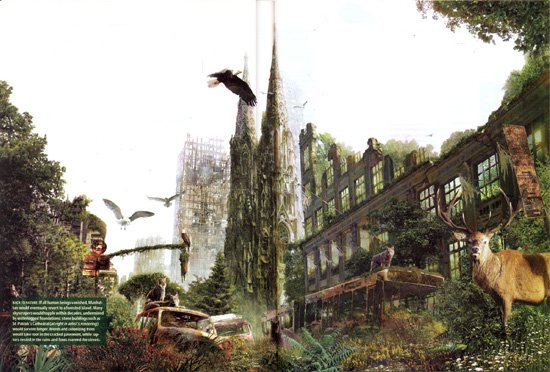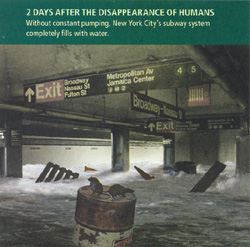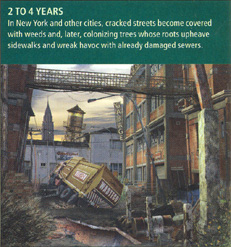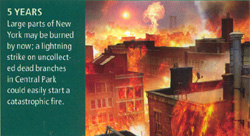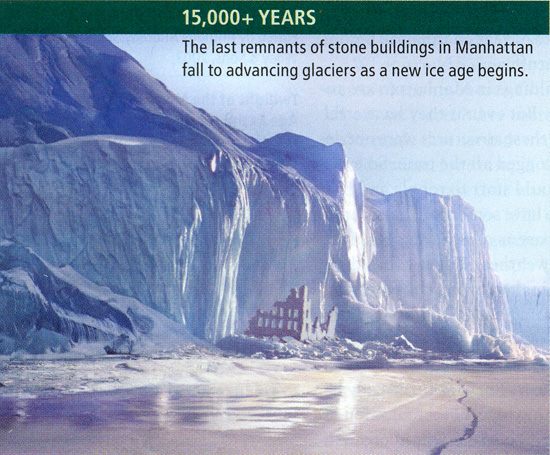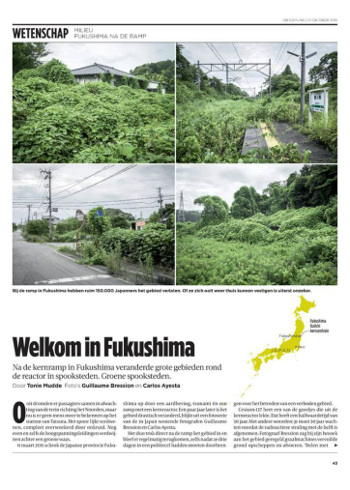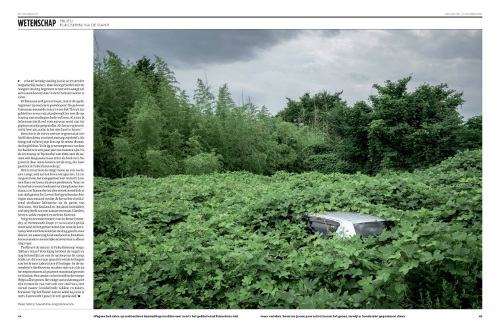Bronnen bij Nabije toekomst: zonder mensheid
Een toekomst zonder mensheid is geen onbekend begrip in de sciencefiction
van rond de jaren zestig. Maar meer recent kwam er wijder aandacht voor toen
literatuurprofessor Alan Weisman er een boek over schreef genaamd The
World without Us. Naar aanleiding van het verschijnen (juni 2007) heeft
Scientific American (juni 2007) een artikel gewijd aan hetzelfde
onderwerp. Onderstaand wat illustraties uit dit artikel, als mogelijke visie
op het verval (de middelste vier plaatjes en de tekst in het bovenste kunnen
door erop te klikken vergroot worden).
Tussengevoegd, een bericht 2015, vier jaar na de kernramp
in Fulushima (de Volkskrant, 18-10-2015, door Tonie Mudde. Foto's: Guillaume Bression -
Carlos Ayesta):
En de beelden:
Met als conclusie: die illustraties uit Scientific American
onderschatten vermoedelijk de snelheid waarmee dit proces gaat.
Terug naar de chronologie. Want na het verschijnen van de SciAm-publicatie
kwam er ook ruimer aandacht voor het onderwerp
(de Volkskrant, 06-09-2008, door Wim Wirtz):
En ook de "echte" wetenschap durft zich met de zaak te bemoeien (New Scientist, 4/5/2008, Vol. 197 Issue 2650, p32-35, door Debora
MacKenzie):
| |
Are we doomed?
The very nature of civilisation may make its demise inevitable, says Debora
MacKenzie
DOOMSDAY. The end of civilisation. Literature and film abound with tales of
plague, famine and wars which ravage the planet, leaving a few survivors
scratching out a primitive existence amid the ruins. Every civilisation in
history has collapsed, after all. Why should ours be any different?
Doomsday scenarios typically feature a knockout blow: a
massive asteroid, all-out nuclear war or a catastrophic pandemic. Yet there is
another chilling possibility: what if the very nature of civilisation means that
ours, like all the others, is destined to collapse sooner or later?
A few researchers have been making such claims for years.
Disturbingly, recent insights from fields such as complexity theory suggest that
they are right. It appears that once a society develops beyond a certain level
of complexity it becomes increasingly fragile. Eventually, it reaches a point at
which even a relatively minor disturbance can bring everything crashing down.
Some say we have already reached this point, and that it is
time to start thinking about how we might manage collapse. Others insist it is
not yet too late, and that we can - we must - act now to keep disaster at bay.
History is not on our side. Think of Sumeria, of ancient
Egypt and of the Maya. In his 2005 best-seller, Jared Diamond of the University
of California, Los Angeles, blamed environmental mismanagement for the fall of
the Mayan civilisation and others, and warned that we might be heading the same
way unless we choose to stop destroying our environmental support systems.
Lester Brown of the Earth Policy Institute in Washington DC
agrees. He has that governments must pay more attention to vital environmental
resources. "It's not about saving the planet. It's about saving civilisation,"
he says.
Others think our problems run deeper. From the moment our
ancestors started to settle down and build cities, we have had to find solutions
to the problems that success brings. "For the past 10,000 years, problem solving
has produced increasing complexity in human societies," says Joseph Tainter, an
archaeologist at the University of Utah, Salt Lake City, and author of the 1988
book The Collapse of Complex Societies.
If crops fail because rain is patchy, build irrigation
canals. When they silt up, organise dredging crews. When the bigger crop yields
lead to a bigger population, build more canals. When there are too many for ad
hoc repairs, install a management bureaucracy, and tax people to pay for it.
When they complain, invent tax inspectors and a system to record the sums paid.
That much the Sumerians knew.
Diminishing returns
There is, however, a price to be paid. Every extra layer of organisation imposes
a cost in terms of energy, the common currency of all human efforts, from
building canals to educating scribes. And increasing complexity, Tainter
realised, produces diminishing returns. The extra food produced by each extra
hour of labour - or joule of energy invested per farmed hectare - diminishes as
that investment mounts. We see the same thing today in a declining number of
patents per dollar invested in research as that research investment mounts. This
law of diminishing returns appears everywhere, Tainter says.
To keep growing, societies must keep solving problems as they
arise. Yet each problem solved means more complexity. Success generates a larger
population, more kinds of specialists, more resources to manage, more
information to juggle - and, ultimately, less bang for your buck.
Eventually, says Tainter, the point is reached when all the
energy and resources available to a society are required just to maintain its
existing level of complexity. Then when the climate changes or barbarians
invade, overstretched institutions break down and civil order collapses. What
emerges is a less complex society, which is organised on a smaller scale or has
been taken over by another group. ...
Is Tainter right? An analysis of complex systems has led
Yaneer Bar-Yam, head of the New England Complex Systems Institute in Cambridge,
Massachusetts, to the same conclusion that Tainter reached from studying
history. Social organisations become steadily more complex as they are required
to deal both with environmental problems and with challenges from neighbouring
societies that are also becoming more complex, Bar-Yam says. This eventually
leads to a fundamental shift in the way the society is organised.
"To run a hierarchy, managers cannot be less complex than the
system they are managing," Bar-Yam says. As complexity increases, societies add
ever more layers of management but, ultimately in a hierarchy, one individual
has to try and get their head around the whole thing, and this starts to become
impossible. At that point, hierarchies give way to networks in which
decision-making is distributed. We are at this point.
This shift to decentralised networks has led to a widespread
belief that modern society is more resilient than the old hierarchical systems.
"I don't foresee a collapse in society because of increased complexity," says
futurologist and industry consultant Ray Hammond. "Our strength is in our highly
distributed decision making." This, he says, makes modern western societies more
resilient than those like the old Soviet Union, in which decision making was
centralised.
Things are not that simple, says Thomas Homer-Dixon, a
political scientist at the University of Toronto, Canada, and author of the 2006
book The Upside of Down. "Initially, increasing connectedness and diversity
helps: if one village has a crop failure, it can get food from another village
that didn't."
As connections increase, though, networked systems become
increasingly tightly coupled. This means the impacts of failures can propagate:
the more closely those two villages come to depend on each other, the more both
will suffer if either has a problem. "Complexity leads to higher vulnerability
in some ways," says Bar-Yam. "This is not widely understood."
The reason is that as networks become ever tighter, they
start to transmit shocks rather than absorb them. "The intricate networks that
tightly connect us together - and move people, materials, information, money and
energy - amplify and transmit any shock," says Homer-Dixon. "A financial crisis,
a terrorist attack or a disease outbreak has almost instant destabilising
effects, from one side of the world to the other."
For instance, in 2003 large areas of North America and Europe
suffered when apparently insignificant nodes of their respective electricity
grids failed. And this year China suffered a similar blackout after heavy snow
hit power lines. Tightly coupled networks like these create the potential for
propagating failure across many critical industries, says Charles Perrow of Yale
University, a leading authority on industrial accidents and disasters.
Credit crunch
Perrow says interconnectedness in the global production system has now reached
the point where "a breakdown anywhere increasingly means a breakdown
everywhere". This is especially true of the world's financial systems, where the
coupling is very tight. "Now we have a debt crisis with the biggest player, the
US. The consequences could be enormous."
"A networked society behaves like a multicellular organism,"
says Bar-Yam, "random damage is like lopping a chunk off a sheep." Whether or
not the sheep survives depends on which chunk is lost. And while we are pretty
sure which chunks a sheep needs, it isn't clear - it may not even be predictable
- which chunks of our densely networked civilisation are critical, until it's
too late.
"When we do the analysis, almost any part is critical if you
lose enough of it," says Bar-Yam. "Now that we can ask questions of such systems
in more sophisticated ways, we are discovering that they can be very vulnerable.
That means civilisation is very vulnerable."
... Nevertheless, Homer-Dixon thinks we should be taking
action now. "First, we need to encourage distributed and decentralised
production of vital goods like energy and food," he says. "Second, we need to
remember that slack isn't always waste. A manufacturing company with a large
inventory may lose some money on warehousing, but it can keep running even if
its suppliers are temporarily out of action."
The electricity industry in the US has already started
identifying hubs in the grid with no redundancy available and is putting some
back in, Homer-Dixon points out. Governments could encourage other sectors to
follow suit. The trouble is that in a world of fierce competition, private
companies will always increase efficiency unless governments subsidise
inefficiency in the public interest. ...
"This is the fundamental challenge humankind faces. We need
to allow for the healthy breakdown in natural function in our societies in a way
that doesn't produce catastrophic collapse, but instead leads to healthy
renewal," Homer-Dixon says. This is what happens in forests, which are a patchy
mix of old growth and newer areas created by disease or fire. If the ecosystem
in one patch collapses, it is recolonised and renewed by younger forest
elsewhere. We must allow partial breakdown here and there, followed by renewal,
he says, rather than trying so hard to avert breakdown by increasing complexity
that any resulting crisis is actually worse.
Lester Brown thinks we are fast running out of time. "The
world can no longer afford to waste a day. We need a Great Mobilisation, as we
had in wartime," he says. "There has been tremendous progress in just the past
few years. For the first time, I am starting to see how an alternative economy
might emerge. But it's now a race between tipping points - which will come
first, a switch to sustainable technology, or collapse?"
Tainter is not convinced that even new technology will save
civilisation in the long run. "I sometimes think of this as a 'faith-based'
approach to the future," he says. Even a society reinvigorated by cheap new
energy sources will eventually face the problem of diminishing returns once
more. Innovation itself might be subject to diminishing returns, or perhaps
absolute limits.
Studies of the way by Luis Bettencourt of the Los Alamos
National Laboratory, New Mexico, support this idea. His team's work suggests
that an ever-faster rate of innovation is required to keep cities growing and
prevent stagnation or collapse, and in the long run this cannot be sustainable.
The stakes are high. Historically, collapse always led to a
fall in population. "Today's population levels depend on fossil fuels and
industrial agriculture," says Tainter. "Take those away and there would be a
reduction in the Earth's population that is too gruesome to think about."
If industrialised civilisation does fall, the urban masses -
half the world's population - will be most vulnerable. Much of our hard-won
knowledge could be lost, too. "The people with the least to lose are subsistence
farmers," Bar-Yam observes, and for some who survive, conditions might actually
improve. Perhaps the meek really will inherit the Earth. |
Het idee van het opsplitsen van de economie in min
of meer zelfstandig functionerende lokale eenheden is al geformuleerd door de
redactie hier
 . .
De kans op het tot stand komen van zoiets is niet groot - zegt
bijvoorbeeld ook de volgende waarnemer, tezamen met het noemen van de
waarschijnlijke grootste horde (de Volkskrant, 02-08-2008):
Er volgde niet veel.
Een nieuwe poging in de publiciteit (de Volkskrant, 23-09-2009, van verslaggever Martijn van Calmthout):
En zeg niet dat er niet allang gewaarschuwd is (de Volkskrant, 09-01-2010, door Martijn van Calmthout):
Een voorbeeldje van dat laatste (de Volkskrant, 02-01-2010, door Leon
de Winter):
En waarom krijgt deze nitwit (op dit vakgebied) deze ruimte in de
krant: omdat hij een bekende schrijver is. ...
Terug naar de meer redelijke mensen (de Volkskrant, 24-09-2011, door Gerard Reijn):
Aanvulling in 2019: dit lijkt tot nu toe allemaal naadloos uit te komen
...
Naar De toekomst
 ,
of site
home ,
of site
home
 ·. ·.
|
